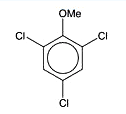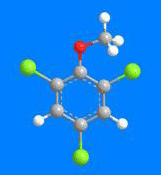

2,4,6-Trichloroanisole (TCA), first synthesized by M. Kohn and M. Heller in 1925, was formerly used as an “assistant” in polyester fiber dyeing. It is also a fungal metabolite produced from the fungicide 2,4,6-trichlorophenol.
TCA, however, is mainly known for causing cork taint that can give wine a musty smell and taste. Until recently, the prevailing wisdom was that it was generated by molds in contaminated corks. But H. Takeuchi and T. Kurahashi of Osaka University (Japan) discovered that TCA contaminates many foods and beverages and that it blocks a protein ion channel associated with olfactory sensing. It may also cause foods to spoil, which would intensify their off-taste.
MOTW update:
September 19, 2022
2,4,6-Trichloroanisole1 (TCA) is the molecule responsible for “cork taint”, which gives wine a musty smell and taste and is also known to contaminate other beverages and some foods.
This August, Luca Cappellin and colleagues at the University of Padua and Illycaffè sPa (Trieste, both in Italy) disclosed a method for screening green coffee beans for TCA contamination, a phenomenon known as the “Rio defect”. They used chemical ionization time-of-flight mass spectrometry with a Vocus2 ion source and an ion-molecule reactor to analyze 22 Coffea arabica bean samples, four of which exhibited the Rio defect according to a panel of cup-tasting experts. The results were available in 3 s and correlated strongly with the panel’s findings.
1. CAS Reg. No. 87-40-1.
2. Aerodyne Research, Billerica, MA.

Learn more about this molecule from CAS, the most authoritative and comprehensive source for chemical information.
Molecule of the Week needs your suggestions!
If your favorite molecule is not in our archive, please send us a message. The molecule can be notable for its current or historical importance or for any quirky reason. Thank you!
Stay Ahead of the Chemistry Curve
Learn how ACS can help you stay ahead in the world of chemistry.

